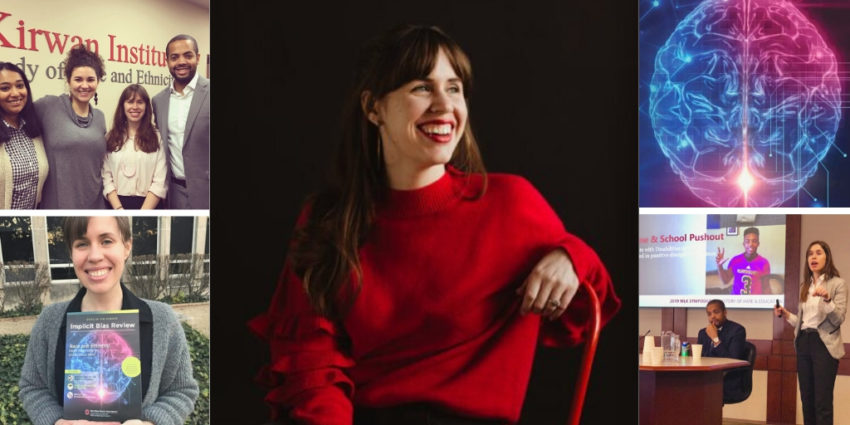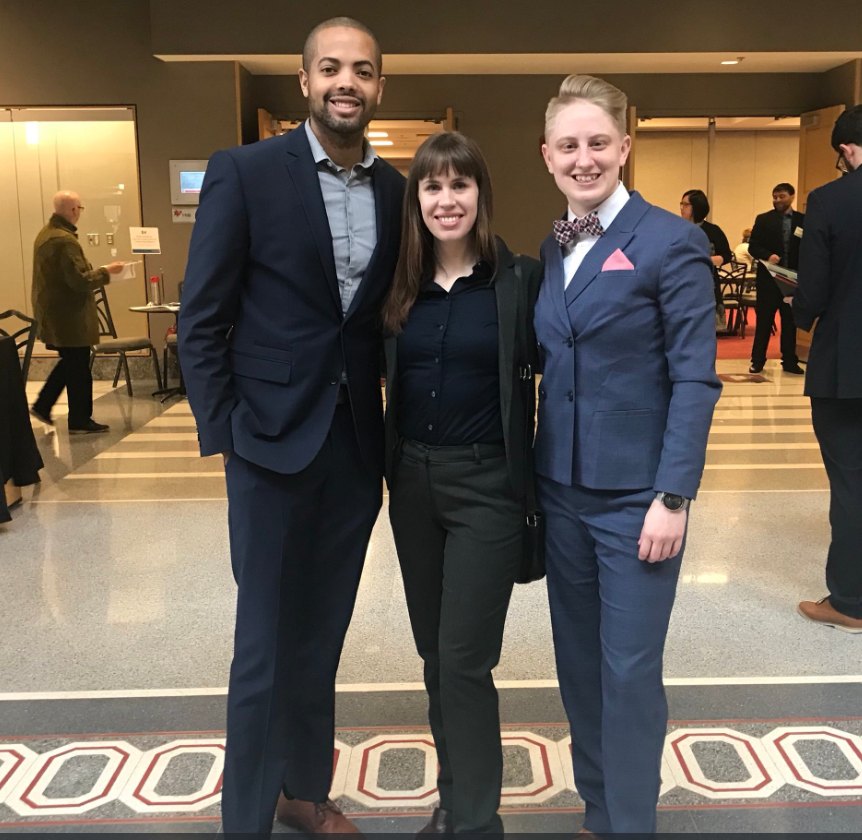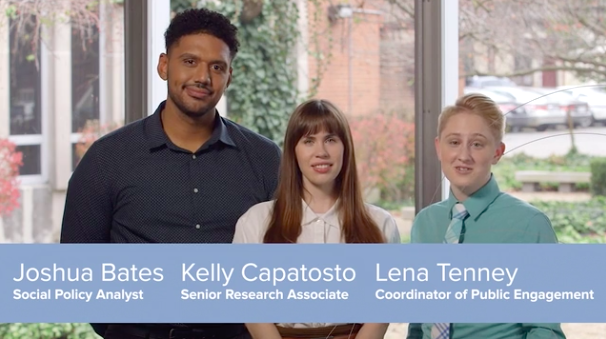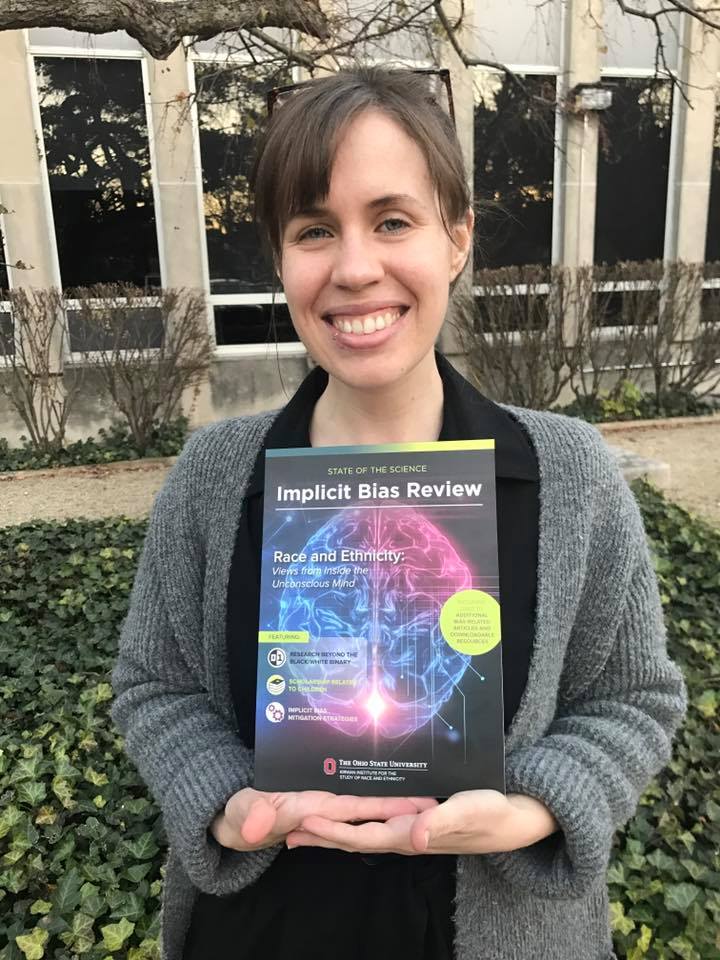
Share On Social!
What is the motivation behind your day job? For Kelly Capatosto, it is her family and the Latino population.
Capatosto, who started exploring implicit racial bias in school discipline at the Kirwan Institute for the Study of Race and Ethnicity at Ohio State University, wanted to help her family and make them proud.
At the same time, she is making a huge impact on health equity for her community.
Capatosto and the Kirwan Institute are generating significant research and training on implicit bias—the attitudes or stereotypes that affect our understanding, actions, and decisions unconsciously. Implicit bias has a big impact on Latino health equity.
“When we got the funding to start working this implicit bias training, we were also living in a different world than it is today,” Capatosto said. “Since that happened, there has been a lot more implicit bias that is coming to the surface.”
Kelly Capatosto’s Experience with Implicit Bias
Capatosto’s family is what drove her to start exploring racial bias.
“My grandma is an immigrant of Colombia. My aunt actually experienced very explicit discrimination at a hospital. She went in for heart failure and has a very thick Spanish accent, and during her stay, a lot of the attendants and a lot of the nurses were making fun of her accent and were saying that they couldn’t really help and assist her because they were saying that they couldn’t understand her. It was obviously a very humiliating and demoralizing experience, she was literally just wanting to be as comfortable as possible,” Capatosto said.

These situations are not unheard of; skin color may determine the quality of care hospitals give.
Also, many studies show physicians—especially white physicians—have implicit, subconscious preferences for white patients over those of color.
Fortunately, Capatosto’s aunt was able to tell her niece about her experience.
Not everyone who experiences bias has the opportunity to tell their story. This is the root of the problem. People don’t know that implicit bias is a very real situation. Hence the meaning of implicit—it is unconscious.
“[My aunt] knew about the research that I do, and she asked me to continue doing the work and to continue to put through voices out there and to share her experience, just because of how vulnerable it was,” Capatosto told Salud America!
Capatosto had her own experience with implicit bias, too.
“People don’t really think that I’m Latino, so as much as I can I elevate stories and experiences of my family and use the privilege and understanding of the work that I do,” she said. “That is really where I see my role, being where I can contribute. It is very meaningful for me to have some of these outlets to speak on behalf of my family.”
What Really is Implicit Bias?

The Kirwan Institute defines implicit bias as the following:
- Implicit biases are pervasive. Everyone possesses them, even people with avowed commitments to impartiality, such as judges.
- Implicit and explicit biases are related but distinct mental constructs. They are not mutually exclusive and may even reinforce each other.
- The implicit associations we hold do not necessarily align with our declared beliefs or even reflect stances we would explicitly endorse.
- We generally tend to hold implicit biases that favor our own ingroup, though research has shown that we can still keep implicit biases against our ingroup.
- Implicit biases are malleable. Our brains are incredibly complex, and the implicit associations that we have formed can be gradually unlearned through a variety of debiasing techniques.
Implicit bias is a complex issue, especially for Latinos.
How Does Implicit Bias Affect Latinos?
Capatosto works tirelessly for the Latino community, who she says experiences bias every day.
Like Capatosto’s aunt and grandmother. Like San Antonio demographer Rogelio Saenz. In schools and the doctor’s office. In business funding and hiring processes.

“We have a lot of explicit and over oppression still going on very frequently to this day, and I always want to make that the forefront of the conversation, especially if we are talking about Latinx folks and the climate around that today,” Capatosto said. “I want to make sure that talking about implicit bias isn’t detracting away from the very real discrimination and the very harmful narratives about that community that hopefully all of us together are going to be able to challenge and reshape moving forward.”
How could Capatosto and the Kirwan Institute help people understand and overcome their biases?
Kirwan Institute’s Implicit Bias Training
Implicit bias training has increasingly sprung up across the United States.
Police departments, businesses, and schools are getting training to understand implicit biases.
“Implicit bias is needed in all organizations because it is increasingly beneficial if it is taught with the proper amount of content, length of time, and audience,” according to The Training Associates. “Effective training enhances awareness as well as promotes organizations and strategic growth.”
The Kirwan Institute breaks it down in easy-to-understand “implicit bias training” modules.
These specific modules are tailored to K-12 educators, due to the impact of bias on learning and the extensive school discipline disparities that show students of color suffer harsher discipline than their peers.
“Kirwan believes in the importance of education and training on key topics like implicit bias, historic inequities in the education system, and education policy as a comprehensive approach to addressing disparities in K-12 education outcomes,” according to a news release. “However, many school districts have limited ability to equip teachers and staff with resources and training related to implicit bias due to cost, time requirement, and difficulty accessing materials and resources in a flexible manner.”
Kirwan Institute’s training highlights the relationship between implicit and explicit bias.
These terms can be harder to digest for those of us who don’t have years of experience in research and multiple letters behind our names.
“So we had to really focus a little bit more on making that information less dense and just being mindful of people’s time,” Capatosto said. “I think that a lot of what we do and so much of our work is foundational in respect and dignity.”
Online Implicit Bias Training
It takes specific skills to identify what is truly meaningful, with so much information floating around on the Internet.
A mutual goal of Salud America! and the Kirwan Institute is to spread knowledge of how to create equity for all communities.
That is why the Kirwan Institute makes it modules free and publicly available!
Although the Kirwan Institute didn’t make this training available until 2018, the research behind their work has been years in the making.
“We had been doing in-person trainings for about a year and a half pretty steadily before even getting the grant to work on the online ones,” Capatosto said. “Our online trainings were very much modeled after the ones that we gave in person, just tailored in a way that we felt would be most beneficial and practical to use online.”
While explaining what implicit bias is and how it affects our everyday lives, the modules also go into detail about other real-world situations.
“We can’t spend too much time on the fluff of it; we are making sure that we are also simultaneously not making people get defensive. We don’t want to call them out. This is a really difficult balance to strike,” Capatosto said.
These modules are no longer than the mandatory meetings that people sit through when they acquire a new job. Instead, no matter your race or ethnicity, these modules are speaking to all of us.
The training is reaching thousands of people in different settings.
“We are having one get piloted here at OSU that is specific to healthcare professionals with our Wexner Medical School. That is going to reach 26,000 employees by the end of the pilot series. We will also be able to do one in partnership with the study for social policy that is focused on child welfare,” said Capatosto.
Furthermore, Capatosto was pleased to report that the modules have great feedback from its users.
Because this research is mostly based on people’s attitudes and what each individual has experienced, it is harder to put this into numerical statistics.
Advocating to Reduce Implicit Bias and Increase Health Equity
Capatosto remains fully immersed in the world of education, social cohesion, and physical and mental health.

Many of her reports are housed on the implicit bias and school discipline website. She focuses extensively on the need for trauma-informed care in schools, to help support children who experience traumatic events.
Capatosto has also written reports to connect implicit bias to other aspects of life. This includes co-authoring the annual literature review, the State of the Science: Implicit Bias Review.
You can watch her walk about implicit bias.
The Kirwan Institute also contributed to the Salud America! “Find Out If You Have Implicit Bias and What to Do Next” Action Pack.
This action pack aims to guide people to see if you have implicit bias, reflect and learn from others who have overcome their own implicit bias, and encourage others to learn about implicit bias, too.
More work remains, Capatosto said.
Implicit bias is about attitudes and personal experiences. With Kirwan’s Implicit Bias Module Series, you can change a person’s outlook on life in a little more than 45 minutes.
After all, we can’t solve a problem without knowing what it is first, she says.
Other ways to overcome bias include learning about Latino culture and helping eliminate the inequities that Latinos face even if you aren’t Latino.
“So, I always like to be proud of myself, be proud of the team and elevate the work, but just also use my own family story to illustrate how much more we truly have to do if we are going to change hearts and minds because implicit bias is already there for people that are trying to do their best but might not always be aware,” Capatosto said.
Explore More:
Overcoming Harmful BiasesBy The Numbers
3
Big Excuses
people use to justify discriminatory behavior
This success story was produced by Salud America! with support from the Robert Wood Johnson Foundation.
The stories are intended for educational and informative purposes. References to specific policymakers, individuals, schools, policies, or companies have been included solely to advance these purposes and do not constitute an endorsement, sponsorship, or recommendation. Stories are based on and told by real community members and are the opinions and views of the individuals whose stories are told. Organization and activities described were not supported by Salud America! or the Robert Wood Johnson Foundation and do not necessarily represent the views of Salud America! or the Robert Wood Johnson Foundation.



